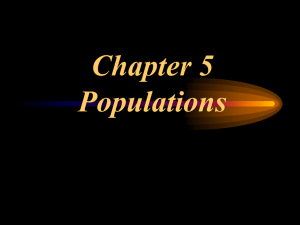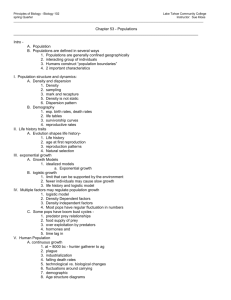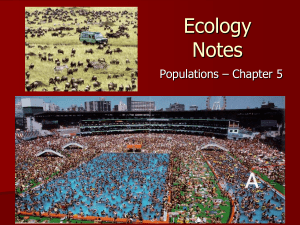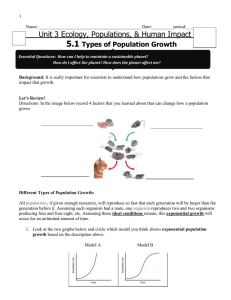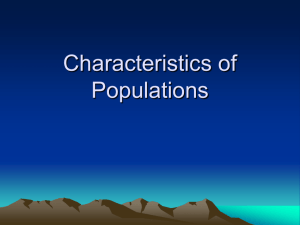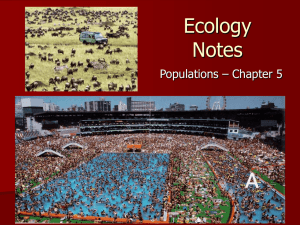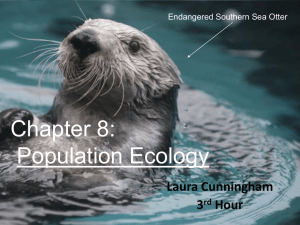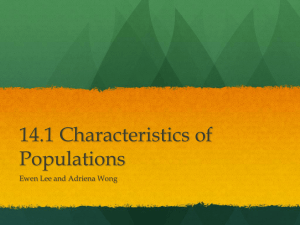Population Ecology
advertisement
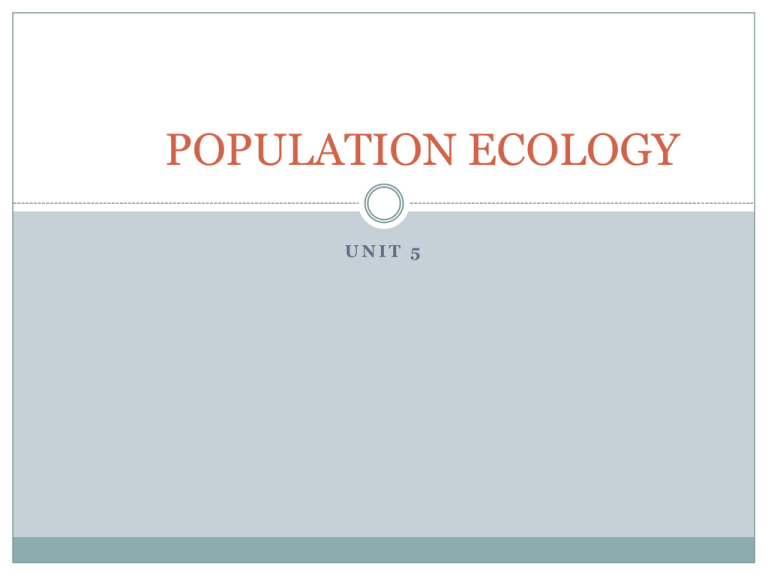
POPULATION ECOLOGY UNIT 5 14.1 – Characteristics of Populations Habitat: the place where an organism or species normally lives. Species: organisms that resemblen one another in appearance, behaviour, chemistry, and genetic makeup, and that interbreed, or have the nability to interbreed, with each other under natural conditions to produce fertile offspring Population Size and Density Population Size: the number of individuals of a specific species occupying a given area/volume at a given time Population Density: the number of individuals of the same species that occur per unit area or volume Crude Density: population density measured in terms of number of organisms of the same species within the total area of the entire habitat Ecological Density: population density measured in terms of the number of individuals of the same species per unit area or volume actually used by the individuals Practice Problem Page 651, #1-3 Dispersion Population Dispersion: the general pattern in which individuals are distributed through a specified area Clumped Dispersion: pattern in which individuals in a population are more concentrated in certain parts of the habitat. Uniform Dispersion: the pattern in which individuals are equally spaced throughout a habitat Random Dispersion: the pattern in which individuals are spread throughout a habitat in an unpredictable and patternless manner Measuring Population Characteristics Very rare to be able to count total # of individuals in a population. Populations are dynamic numbers and geographic location changes over time. Biologists count a sample, and then estimate the total size. Indirect Indicators Number of fecal droppings Number of tracks Number of nests Etc. Why is this important? Ex// in the forestry industry, population density and size of valuable tree species info essential in determining allowable harvest rates while still maintaining healthy and viable populations. Sampling Technique (1) Quadrat: a sampling frame used for estimating population size; frames can be real or virtual Number of individuals of one or more species can be counted within each quadrat population size and density can be estimated through calculations population size and density of entire area estimated. Most effective for stationary species can be used for mobile species as well. Example Problem Page 654 Work through the sample problem Complete #4. Sampling Technique (2) Mark-recapture method: used for mobile populations Can estimate population size and density by comparing the proportion of marked and unmarked animals captured in a given area Sometimes called capture-recapture. Fisheries – restocking programs Large animals Ex// polar bears tranquilized, captured, marked Tags, bands, dye. Control Techniques for capturing and marking individual organisms must be carefully planned chances of each individual being caught is equal. Marking must not harm, or change behaviour, of organism. Marks must not alter the chances of being recaptured. Assumptions of mark-recapture Ideal conditions: No new individuals enter the population No marked organism dies No marked organisms leave the populationjuhb Mark-Recapture Sampling Proportion of marked fish in entire population is expected to equal the proportion of marked recaptures in a sample Sample Problem Page 655 example problems Do PP on page 657. Technological Tracking of Wild Populations Mark-recapture not great for migrating/open-ocean predators (sharks, blue marlin, tuna) One study: <1% of 20,000 tagged blue marlin recaptured. Radio collars, satellite-linked devices, etc. Tracking migration/behaviour patterns. Cannot restrict or harm animals. Microcomputers: attached to dorsal area of fish by use of a harpoon. Ethics of Studying Wild Populations Possibilities Handling of animals during experiments can affect animal’s behaviour act differently after release? CCAC: Canadian Council on Animal Care Three Rs: reduction, refinement, and replacement Reduction: limit use of animals as much as possible in the study Refinement: tweak methods to minimize pain and distress. Replacement: replace trapping of animals wherever possible with computer simulations. Seatwork/Homework Page 659, #2 – 6. 14.2 – Measuring and Modelling Population Change Carrying capacity: the maximum number of organisms that can be sustained by available resources over a given period of time. Dynamic: environmental conditions always changing. Nutrient-poor lake would have smaller carrying capacity per unit area than a nutrient-rich lake. Oligotrophic: lacking in nutrients. Eutrophic: nutrient-rich. When populations increase in size, amount of resources available per individual decreases. Factors that Affect Population Growth Populations are always changing Experience natural hourly, daily, seasonal, and annual fluctuations. Births and deaths Immigration (in) & emigration (out) Population dynamics: changes in population characteristics determined by natality, mortality, immigration, emigration. Fecundity: potential for a species to produce offspring in one lifetime. Ex// starfish: >1 million eggs/year. Survivorship Curves Type I: low mortality rates until beyond reproductive years. Type II: Uniform risk of mortality through life. Type III: High mortality rates when young: green sea turtle (hundreds of eggs, less than 1% reach sexual maturity). Under natural conditions, fertility is often significantly less than fecundity. Calculating Changes in Population Sizes Population growth can be calculated by the formula: Expressed as a percentage Open population a population in which change in number and density is determined by births, deaths, immigration, and emigration Closed population a population in which change in size and density is determined by natality (birth rate) and mortality (death rate) alone Rare: secluded islands “Effectively closed:” short period between mark-recapture: population is virtually closed. Bacterial colonies Biotic Potential Biotic potential: the maximum rate a population can increase under ideal conditions. Population Growth Models Illustrated by graphing change in population size over time. If birth rates and death rates per individual remains constant, population grows at a fixed time interval. Ratio or percent: 1.05 or 5% / year. Human population: growth is continuous Deaths and births occur at all times. Many other species: intermittent Births restricted to breeding season Geometric growth: a pattern of population growth where organisms reproduce at fixed intervals at a constant rate Growth Rate Ratio Lambda: fixed growth rate N is population size in year (t + 1) and (t) respectively. We can find population size at any time by rearranging the equation: Sample/Practice Problems Sample problem, Page 663. Practice Problem, Page 664 #1 Exponential Growth Exponential Growth: a pattern of population growth where organisms reproduce continuously at a constant rate Chosen time interval is not restricted to that of a particular reproductive cycle. Can determine instantaneous growth rate of the population expressed in terms of intrinsic (per capita) growth rate (r). dN/dt instantaneous growth rate of population r growth rate per capita N population size Doubling Time For any population growing exponentially, time needed for population to double in size, td, is a constant. For example, if a population has a per capita growth rate of 0.020 per year (a 2% growth rate), the approximate time needed for the population to double would be 0.69/0.020 or 34.5 years. Sample/Practice Problem Sample Problem, page 665. Practice Problem #2, page 665. Geometric vs. Exponential Growth Exponential: smooth continuous reproduction Increase in numbers rapidly, resulting in a J-shape growth curve. Geometric Curve: fluctuates as a result of seasonal or intermittent reproductive cycles. Drawn as smooth curves long-term seasonal fluctuations. Modelling Logistic Growth Geometric & Exponential: assume growth at same rate indefinitely. Population has continuous access and unlimited supply of resources. r is a maximum, rmax. Not the case in the real world! New population: resources plentiful As population grows, food, water, light, space in the ecosystem can limit population growth. Growth rate drops below rmax. Number of deaths approach number of births stable equilibrium. Carrying Capacity When births = deaths. K: population number at the carrying capacity. Logistic growth: represents the effect of carrying capacity on the growth of a population. Most common growth pattern seen in nature. Logistic Growth Equation Note: if N close to K, then dN/dt = 0 growth virtually ceases. Sample/Practice Problem Sample Problem, page 667. Practice Problem #3, 4 page 668. Logistic Growth Curve Three phases to a logistic growth curve Shape resembles an S (sigmoidal) Example of Logistic Growth Population of fur seals: St. Paul Island, Alaska. Hunting banned in 1911 (seal population low) Many unused resources Population grew rapidly carrying capacity reached logistic growth curve. Vague Summary Seatwork/Homework Page 667, #1-6 14.3 – Factors Affecting Population Change Read/make notes on section 14.3 Practice Problems, page 675, #1-5.

